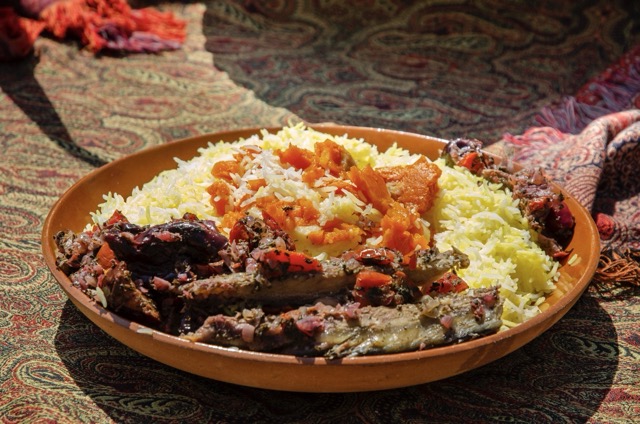Affiliate Disclaimer: As an Amazon Associate I earn from qualifying purchases.
If you’re looking for a cookbook that is more than just a collection of recipes—something that brings together culture, history, photography, and personal travel experiences—Taste of Persia: A Cook’s Travels Through Armenia, Azerbaijan, Georgia, Iran, and Kurdistan by Naomi Duguid is a compelling addition to your library. First published in 2016, this richly illustrated hardcover book is a journey across a diverse yet interconnected cultural landscape, tied together by centuries of Persian influence.
Naomi Duguid, known for her ethnographic approach to food writing, delivers more than just culinary instructions. With Taste of Persia, she offers a window into the lives and kitchens of people throughout the extended Persian cultural world—ranging from the highland villages of Armenia to the ancient cities of Iran, from Georgian vineyards to Kurdish mountain markets. Every page is a blend of storytelling, food anthropology, and visual immersion.
A Cookbook and Travelogue in One
Unlike traditional cookbooks that follow a rigid chapter structure based on appetizers, mains, and desserts, Taste of Persia is organized more like a travel diary. Duguid takes readers along her journey through each region, interweaving recipes with vivid travel narratives and cultural insights. This creates a reading experience that is both informative and emotionally engaging.
Each section includes:
- Regional background and historical context
- Full-page color photographs of landscapes, local people, and street scenes
- Recipes ranging from home-style comfort foods to festival dishes
- Personal anecdotes that bring the recipes to life
It’s this combination of depth and accessibility that makes the book stand out. You’re not just learning how to cook; you’re being invited to understand the people and traditions behind the food.
Recipes That Tell Stories
The recipes themselves are well-curated and represent a thoughtful cross-section of the regions Duguid visits. Some examples include:
- Ash-e reshteh (a thick Persian noodle and herb soup)
- Kuku sabzi (a vibrant green Persian herb frittata)
- Georgian khachapuri (cheese-filled bread)
- Kurdish lentil soup
- Armenian pickles and preserves
- Azerbaijani pilafs with saffron and dried fruits
The instructions are clear without being overly prescriptive. Duguid assumes a certain level of culinary curiosity but avoids intimidating language. Ingredients are generally accessible, with notes for substitutions when needed. Most importantly, each dish is introduced with context—where it’s eaten, when it’s served, and what it means to the people who prepare it.
Visuals and Production Quality
The visual presentation is one of the book’s strongest points. The photography, much of which was shot on location by Duguid herself, is natural and documentary-style rather than overly stylized. This choice gives the book a raw, authentic feel that matches its subject matter.
The hardcover edition feels durable and substantial, with high-quality paper and binding. It’s the kind of book that looks good on a coffee table but also holds up to repeated use in the kitchen.
Persian Influence Beyond Iran
What makes this book unique is its approach to Persia as a cultural region rather than a modern political state. Duguid shows how Persian language, foodways, and customs have influenced—and been influenced by—the neighboring cultures of the Caucasus and Mesopotamia. This perspective broadens the reader’s understanding of what “Persian food” really is.
By crossing contemporary borders, Taste of Persia quietly challenges the idea that food belongs only within national boundaries. It’s a timely reminder that cuisine, like culture itself, is shared, borrowed, and evolved over generations.
Who Is This Book For?
- Home cooks looking to expand into Middle Eastern or Central Asian cooking
- Travelers and culture enthusiasts who appreciate immersive food writing
- Historians and anthropologists interested in the Persian world and its diasporic influence
- Photographers and designers who enjoy strong visual storytelling
Whether you’re preparing a meal or simply seeking a deeper appreciation of global food traditions, this book delivers on both levels.
Final Thoughts
Taste of Persia is not just a cookbook—it’s a tribute to the people, places, and flavors that have shaped the Persian world across centuries and borders. Naomi Duguid’s careful attention to context, combined with her heartfelt storytelling and visual sensitivity, makes this a standout work in the genre of culinary travel writing.
This is a book you’ll return to again and again—not only to cook, but to read, to reflect, and to learn.
If you’re ready to take your next culinary adventure beyond the map, you can find Taste of Persia on Amazon here:
👉 Buy Taste of Persia on Amazon
Bridging Borders: How Taste of Persia Reveals a Shared Cultural Thread
One of the most striking achievements of Taste of Persia is its ability to transcend modern political borders and reveal the deeper cultural connections that unite the regions of Armenia, Azerbaijan, Georgia, Iran, and Kurdistan. While each of these places has its own national identity, language, and political history, Duguid focuses on the threads of cultural continuity—especially through food—that tell a different story: one of shared traditions, mutual influence, and centuries of cohabitation.
Persian culture, in its broadest historical sense, has never been limited to the boundaries of modern Iran. From the imperial reach of the Achaemenid and Sassanian empires to the more fluid exchanges of the Silk Road, Persia functioned as a cultural superhighway—absorbing, adapting, and redistributing ideas, ingredients, and customs across a wide territory. The recipes in the book are living artifacts of this process.
Take, for example, the way rice is prepared differently across the region. In Iran, rice is often steamed with saffron to create the golden, crispy tahdig crust. In Azerbaijan, pilaf includes dried fruits and nuts, reflecting Turkic and Central Asian influences. In Georgia, where rice is less common, grains like corn and wheat dominate, but Persian-inspired stews still find their way onto the table. These regional variations aren’t signs of divergence—they’re evidence of cultural conversation.
Likewise, the book highlights how herbs, yogurt, flatbreads, and pomegranate are foundational across borders. You begin to see that culinary identity in this part of the world is not isolated by nation-state boundaries, but rather woven into a vast, interconnected fabric—one in which Persian culture has played a continuous and formative role.
This kind of narrative is increasingly important in today’s world. At a time when the news often emphasizes conflict and division, Taste of Persia offers a gentle but powerful counterpoint. It reminds us that shared meals, everyday ingredients, and local food traditions often reveal a deeper, more human layer of connection—one that endures despite shifting borders and political tensions.
In this sense, Duguid’s work is not only a celebration of culinary artistry but also an act of cultural preservation and bridge-building. It preserves not just recipes, but relationships—between people, between places, and between the past and present.
By reading and cooking from this book, you’re not just exploring the cuisine of a single country. You’re participating in a much larger story—one that spans centuries, crosses mountains, and continues to evolve with every dish shared.
Naomi Duguid’s Method: Writing with Curiosity, Cooking with Humility
What sets Taste of Persia apart from other cookbooks is Naomi Duguid’s distinctive voice—part observer, part participant, always respectful. Her writing style is not that of a chef giving orders, nor a tourist snapping pictures from the sidelines. Instead, she writes as a quiet guest invited into kitchens, market stalls, and everyday lives, asking questions, listening, tasting, and then carefully translating those experiences into words.
Her approach is best described as culinary ethnography. Rather than extracting recipes as static objects, Duguid documents them within the rhythms of the cultures that produce them. She explains how dishes vary from town to town, how seasonality shapes preparation, and how oral tradition—rather than written instruction—often governs what is made and how. In doing so, she conveys not just ingredients and measurements, but the intangible knowledge of lived practice.
For example, a simple recipe for Kurdish flatbread might be accompanied by a story about the baker’s family history, the way flour is ground in local mills, or the significance of that bread in a village festival. The result is not just a meal on a plate, but a portal into how food connects people to land, memory, and identity.
Duguid is also highly attuned to the sensory environment of the places she visits. Her descriptions of spices warming over open flames, or walnuts being cracked on stone floors, are vivid without being romanticized. She doesn’t try to polish every detail for dramatic effect. Instead, she offers a documentarian’s eye, allowing the reader to encounter beauty and imperfection together, just as one might experience it in real life.
Moreover, her humility is evident on every page. She never positions herself as the expert in someone else’s culture. Instead, she invites cooks, farmers, mothers, and vendors to be the authorities, placing their voices at the center of the narrative. In a genre often saturated with ego-driven storytelling, this restraint is rare—and powerful.
By the end of the book, you don’t just feel as though you’ve learned how to make a dish. You feel as though you’ve met someone new—perhaps a bread baker in Tabriz, a home cook in Yerevan, or a cheese vendor in Tbilisi—and that you’ve been given permission to carry a piece of their world back to your own kitchen.
This deep, grounded, and human-centered method is what makes Taste of Persia more than a cookbook. It is a work of culinary diplomacy, a travel journal for the senses, and a respectful tribute to the resilience and richness of Persian-influenced food cultures across the region.
A Rare and Lasting Journey Through the Persian Cultural World
Taste of Persia is more than a cookbook. It is a well-researched, beautifully photographed, and sensitively written journey into a region too often overlooked or oversimplified. Naomi Duguid has created a volume that honors complexity—of flavor, of history, of people—and does so without pretension or spectacle.
Whether you’re a home cook eager to explore new flavor profiles, a traveler seeking cultural depth from your armchair, or a student of the Persian world looking for primary experiences beyond textbook history, this book delivers something meaningful. It is equally at home in the kitchen, on the coffee table, or in the classroom.
What stays with you long after reading isn’t just the taste of saffron or the aroma of freshly baked flatbread. It’s the sense that food—when respected, explored, and shared—has the power to illuminate the full humanity of the people who make it.
If you’re ready to experience this journey yourself, you can find Taste of Persia on Amazon:










